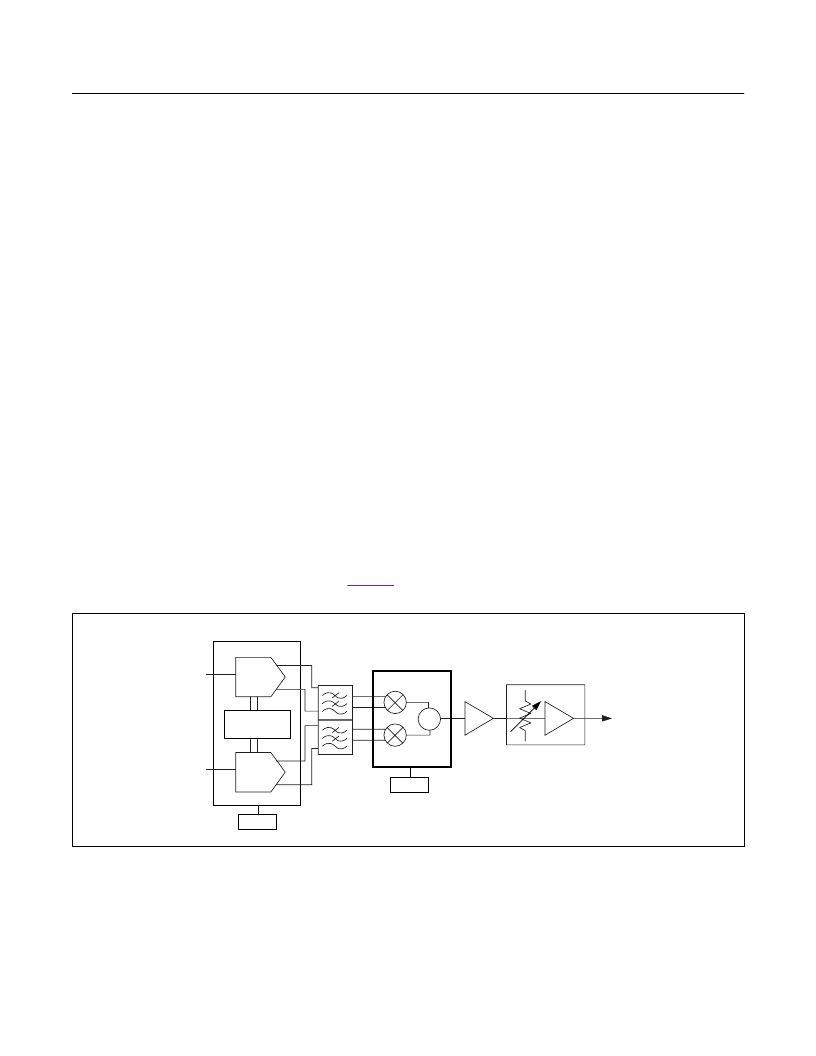- 您现在的位置:买卖IC网 > Sheet目录471 > MAX2022ETX+T (Maxim Integrated)IC MOD 1500MHZ TO 2500MHZ 36TQFN

MAX2022
RF Output
The MAX2022 utilizes an internal passive mixer architec-
ture. This enables a very low noise floor of -173.2dBm/Hz
for low-level signals, below about -20dBm output power
level. For higher output level signals, the noise floor will
be determined by the internal LO noise level at approxi-
mately -162dBc/Hz.
The I/Q input power levels and the insertion loss of the
device will determine the RF output power level. The input
power is the function of the delivered input I and Q voltag-
es to the internal 50? termination. For simple sinusoidal
baseband signals, a level of 89mV P-P differential on the I
and the Q inputs results in an input power level of -17dBm
delivered to the I and Q internal 50? terminations. This
results in a -23.5dBm RF output power.
Generation of WCDMA Carriers
The MAX2022 quadrature modulator makes an ideal sig-
nal source for the generation of multiple WCDMA carriers.
The combination of high OIP3 and exceptionally low out-
put noise floor gives an unprecedented output dynamic
range. The output dynamic range allows the generation of
four WCDMA carriers in the UMTS band with a noise floor
sufficiently low to meet the 3GPP specification require -
ments with no additional RF filtering. This promotes an
extremely simple and efficient transmitter lineup. Figure 2
MAX5895
High-Dynamic-Range, Direct Up/
Downconversion 1500MHz to 3000MHz
Quadrature Modulator/Demodulator
illustrates a complete transmitter lineup for a multicarrier
WCDMA transmitter in the UMTS band.
The MAX5895 dual interpolating-modulating DAC is
operated as a baseband signal generator. For genera-
tion of four carriers of WCDMA modulation, and digital
predistortion, an input data rate of 61.44 or 122.88Mbps
can be used. The DAC can then be programmed to
operate in x8 or x4 interpolation mode, resulting in a
491.52Msps output sample rate. The DAC will gener -
ate four carriers of WCDMA modulation with an ACLR
typically greater than 77dB under these conditions. The
output power will be approximately -18dBm per carrier,
with a noise floor typically less than -144dBc/Hz.
The MAX5895 DAC has built-in gain and offset fine
adjustments. These are programmable by a 3-wire serial
logic interface. The gain adjustment can be used to adjust
the relative gains of the I and Q DAC outputs. This feature
can be used to improve the native sideband suppression
of the MAX2022 quadrature modulator. The gain adjust-
ment resolution of 0.01dB allows sideband nulling down
to approximately -60dB. The offset adjustment can simi-
larly be used to adjust the offset DC output of each I and
Q DAC. These offsets can then be used to improve the
native LO leakage of the MAX2022. The DAC resolution
of 4 LSBs will yield nulled LO leakage of typically less
than -50dBc relative to four-carrier output levels.
I
L-C FILTER
MAX2022
RF-MODULATOR
MAX2057
I/Q GAIN AND
OFFSET ADJUST
I
Q
∑
+12dB
TX
OUTPUT
Q
SYNTH
CLOCK
Figure 2. Complete Transmitter Lineup for a Multicarrier WCDMA in the UMTS Band
www.maximintegrated.com
Maxim Integrated │ 20
发布紧急采购,3分钟左右您将得到回复。
相关PDF资料
MAX2022EVKIT
EVAL KIT FOR MAX2022
MAX2023ETX+T
IC MOD/DEMOD HI DYN RNG 36-TQFN
MAX2027EUP+D
IC AMP VAR GAIN 20-TSSOP
MAX2027EVKIT
EVAL KIT FOR MAX2027
MAX2029ETP+T
IC MIXER UP/DOWN HI LIN 20-TQFN
MAX2031EVKIT
EVAL KIT FOR MAX2031
MAX2032ETP+
IC MIXER UP/DOWN CONVER 20TQFN
MAX2034CTM+
IC AMP LOW NOISE QUAD 48-TQFN
相关代理商/技术参数
MAX2022ETX+TD
功能描述:调节器/解调器 1.5-2.5GHz Quadratr Modulator
RoHS:否 制造商:Texas Instruments 封装 / 箱体:PVQFN-N24 封装:Reel
MAX2022ETX-D
制造商:Maxim Integrated Products 功能描述:HI-DYNAMIC-RANGE, DIRECT UPCONVER - Tape and Reel
MAX2022ETX-T
功能描述:调节器/解调器 1.5GHz-2.5GHz Quad Mod/Demod RoHS:否 制造商:Texas Instruments 封装 / 箱体:PVQFN-N24 封装:Reel
MAX2022EVKIT
功能描述:射频开发工具 RoHS:否 制造商:Taiyo Yuden 产品:Wireless Modules 类型:Wireless Audio 工具用于评估:WYSAAVDX7 频率: 工作电源电压:3.4 V to 5.5 V
MAX2023
制造商:MAXIM 制造商全称:Maxim Integrated Products 功能描述:Evaluation Kit
MAX2023_1
制造商:MAXIM 制造商全称:Maxim Integrated Products 功能描述:Evaluation Kit
MAX2023_V1
制造商:MAXIM 制造商全称:Maxim Integrated Products 功能描述:High-Dynamic-Range, Direct Up-/Downconversion 1500MHz to 2500MHz Quadrature Mod/Demod
MAX2023ETX
功能描述:调节器/解调器 1.5GHz-2.3GHz Quad Mod/Demod RoHS:否 制造商:Texas Instruments 封装 / 箱体:PVQFN-N24 封装:Reel
